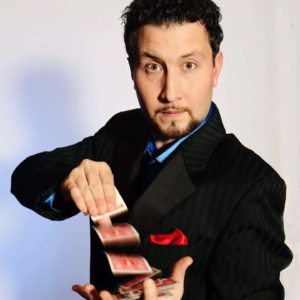You Won’t Believe Your Eyes! (And, Really, You Shouldn’t)
Dr. Pinkerton of Insight Eyecare sponsors Illusionist Johnny Magic’s upcoming “Reality?” show Saturday, Jan. 27, at 7 p.m. at the Gilmer Civic Center. There’s a good reason for the question mark after “Reality”—humans haven’t evolved to see reality as it is, and what we think of as objective reality is actually a construct of our visual system and brain. That’s why we’re susceptible to magic tricks.

Dr. Pinkerton explains.
“While Johnny Magic is performing, the real ‘magic’ will take place not on stage but in the visual system of each audience member,” he says. “Together with our brain, our eyes play tricks on us all the time. That’s because our visual system cannot process all the inputs that constantly bombard our senses. So, to avoid overwhelm, our brains take energy-saving shortcuts.”
One such shortcut is filtering out things that are present in our visual field to better attend to things that matter. The brain considers the context and past experience to determine what matters and what it will block out as irrelevant.
Another shortcut is a process called “filling in.” Our brain does this constantly to compensate for our blind spot. Each of us has a gap in our retinas where the optic nerve leaves the eye on its way to the brain. There are no photoreceptors in this gap, but we’re not aware of the blind spot because our brain guesses what should go there and fills it in.
In fact, we are only able to see a tiny area in full detail and color—about twice the width of your thumbnail at arm’s length. Everything else is indistinct. However, your eyes move around and provide your brain with snapshots to piece together into a full mental picture. Here, too, the brain fills in details based on context and experience.
“Normally, filtering out or filling in information is helpful, but the fact our visual system does this gives magicians their advantage,” Dr. Pinkerton says.

One of the standard techniques in a magician’s bag of tricks is distraction, or misdirection. Using patter, gestures, eye movements, and props, magicians draw our attention from objects or movements they don’t want us to see. For some illusions, the misdirection is so effective that the magician’s secret moves take place right in front of our eyes yet we simply don’t see it (or we don’t register having seen it).
Likewise, magicians exploit the visual system’s tendency to fill in the invisible parts of objects or scenes to create common illusions such as linking and unlinking solid rings and sawing someone in half. Where there’s actually a gap or missing piece, our visual system fills in the blanks to form a picture that makes sense and would normally jibe with reality.
Sometimes, when we learn how a magic trick works, it’s embarrassing how easily we were deceived; however, it’s actually proof of our highly evolved brain and visual system—not to mention the skill of the magician.
“Inattention blindness” takes place when we don’t see something because our attention is trained elsewhere. If you’ve not seen this video, you may be surprised at your test results. About half of first-time test takers fail.
